Replacing the tuning pegs of a acoustic guitar | Stimmwirbel einer Akustikgitarre wechseln [EN|DE]

Hello Hivians and friends of picking the strings,
Over the years, guitar tuning pegs can get weaker and then break. After all, there is a certain degree of wear as they are frequently rotated for tuning and the tension of the strings also takes its toll.
So far, however, I have been lucky - it was the very first time ever recently when a screw of a tuning peg broke while I was tuning one of my guitars.
It was the screw that holds the shaft on which the string is wound. And it broke in a way that I wasn't able to remove it from the shaft.
Well, a total replacement was needed.
In this blog article I described how I managed to replace the tuning pegs. Since I only have experience with an acoustic guitar, this post only refers to acoustic guitars.
Beginner friendly! You won't find any technical jargon here, because I'm absolutely not familiar with that language. :-D

Hallo Hivianer und Freund des Saitenzupfens,
Im Laufe der Jahre, können die Stimmwirbel einer Gitarre schon Mal kaputt gehen. Immerhin unterliegen sie ja einem gewissen Verschleiß, da sie zum Stimmen regelmäßig gedreht werden und auch die Zugspannung der Saiten ihren Tribut fordert.
Bisher hatte ich jedoch Glück - Es ist mir neulich das allererste Mal überhaupt passiert, dass mir beim Stimmen einer meiner Gitarren, die Schraube eines Stimmwirbels gebrochen ist.
Es war jene Schraube, welche dem Stift, auf dem die Saite aufgewickelt ist, Halt verleiht. Und diese ist ausgerechnet so gebrochen, dass ich sie nicht mehr aus dem Stift drehen konnte.
Nun denn, es musste ein kompletter Ersatz her.
Wie ich die Stimmwirbel ausgetauscht habe, beschreibe ich in diesem Blog-Artikel. Da ich dazu nun lediglich Erfahrungen bei einer Akustikgitarre sammeln konnte, bezieht sich dieser Post nur auf Akustikgitarren.
Anfängerfreundlich! Du wirst hier kein Fachchinesisch finden, denn ich kann gar keines. :-D


How to choose the right Tuning Pegs
Basically, there's not much you can do wrong when buying new tuning pegs, as long as you use the tuning pegs that were already fitted when you bought the guitar as a guide.
It is important that the screw holes of the new tuning peg sets match those of the old ones. Otherwise you will have to drill the holes yourself. However, in case the old and the new holes are too close to each other, damage can be caused by tearing the wood of the guitar head at the holes.
The first thing you should pay attention to is the type of the tuning pegs.
Tuning pegs that are attached to the side of the guitar head in a row via a mounting plate cannot simply be replaced with tuning pegs that have to be mounted individually. When buying new tuning pegs, it is best to use the same type of tuning pegs already mounted to your guitar.
Further attention should be paid to the material of the mechanism of the tuning pegs. A mounting plate that is too thin or gears made of too soft metal (copper, aluminium, etc), definitely have a bad effect on durability. If the gears are too soft, they can wear out quickly, making it impossible to tune the guitar at some point.
Numerous reviews from buyers in online shops, warn of exactly this.
In this respect, it is better to visit a shop near your home that sells musical instruments. The staff there usually know their stuff and will recommend the highest quality tuners to you.
You can get a good set of tuning pegs for as cheap as 30 euros (35 US dollars). Price goes up with quality.

Die richtigen Stimmwirbel kaufen.
Im Grunde kann man beim Kauf neuer Stimmwirbel nicht viel falsch machen, solange man sich an den Stimmwirbeln orientiert, die schon beim Kauf der Gitarre montiert waren.
Wichtig ist, dass die Anschraublöcher der neuen Stimmwirbelsätze mit jenen der alten übereinstimmen. Sonst muss man sich die Löcher selbst Bohren. Wenn die alten und die neuen Bohrlöcher jedoch zu nah aneinander liegen, kann es zu zu Schäden durch Ausreißen an den Löchern im Holz des Gitarrenkopfes kommen.
Erstes Hauptaugenmerk sollte der Art der Stimmwirbel gelten.
Stimmwirbel, die seitlich über ein Montageblech in Reihe an der Gitarre befestigt werden, können nicht einfach mit Stimmwirbeln ersetzt werden, die einzeln Montiert werden müssen. Richte dich beim Kauf neuer Stimmwirbel am Besten nach den auf deiner Gitarre bereits befindlichen Stimmwirbeln.
Weiteres Hauptaugenmerk gilt dem Material der Mechaniken des Stimmwirbelsatzes. Ein zu dünnes Montageblech oder Zahnräder aus zu weichem Metal (Kupfer, Aluminium, etc), haben schlechte Auswirkungen auf die Haltbarkeit. Sind die Zahnräder zu weich, können sie sich schnell abnutzen, wodurch die Gitarre irgendwann nicht mehr gestimmt werden kann.
Zahlreiche Bewertungen von Käufern in Online-Geschäften, warnen genau davor.
In dieser Hinsicht ist es daher besser, ein Musikinstrumente-Geschäft in deiner Nähe zu besuchen. Die Mitarbeiter dort, kennen sich in der Regel gut aus und empfehlen meist die qualitativ hochwertigsten Mechaniken.
Einen guten Stimmwirbelsatz, bekommst du schon ab 30 Euro (35 US-Dollars). Der Preis steigt mit der Qualität.
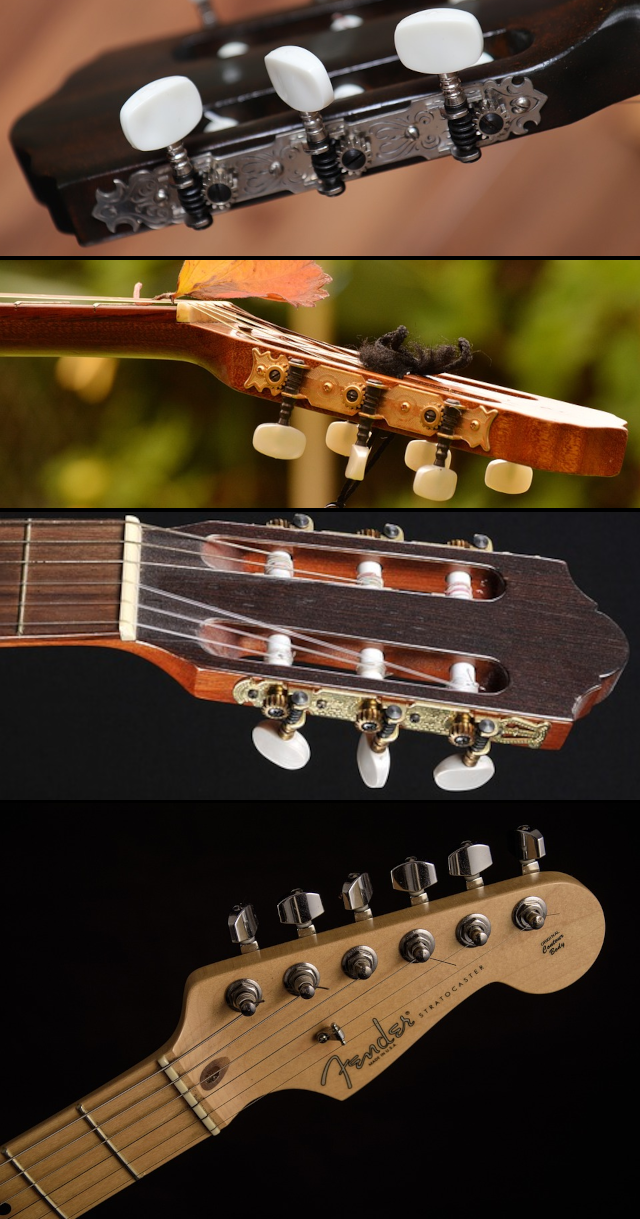

Disassembling
To remove the old tuners, first wind the strings down from the tuning pegs.
If you are not sure which way to turn, turn a little in a random direction - if the tone of the string becomes lower when picked, you have turned in the right direction.
**Tip: After you have unwound the strings, just roll them up to the bridge into small bundles so that they don't get in the way while you are busy doing the rest of the work.
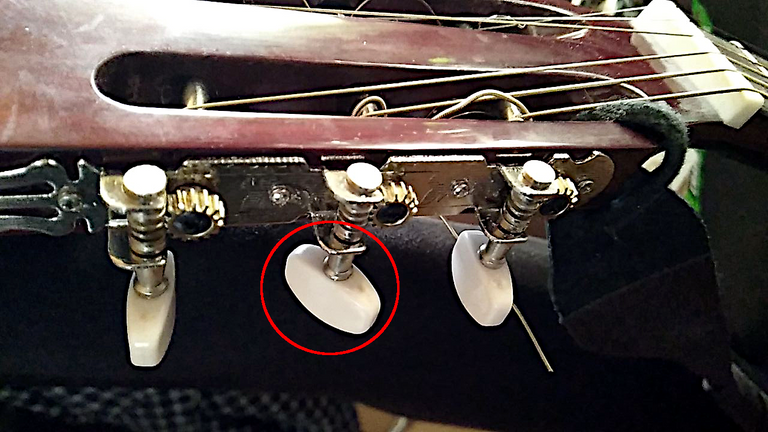
Then you can unscrew the mounting plates. To do this, remove the screws that touch the plate directly (see photo below).
If your guitar is equipped with individual tuning pegs that are not combined in a mounting set, just unscrew the screws that are fixed in the guitar head. They are usually located on the back of the guitar head.
After removing the screws, you can pull the pegs out of the milled holes.
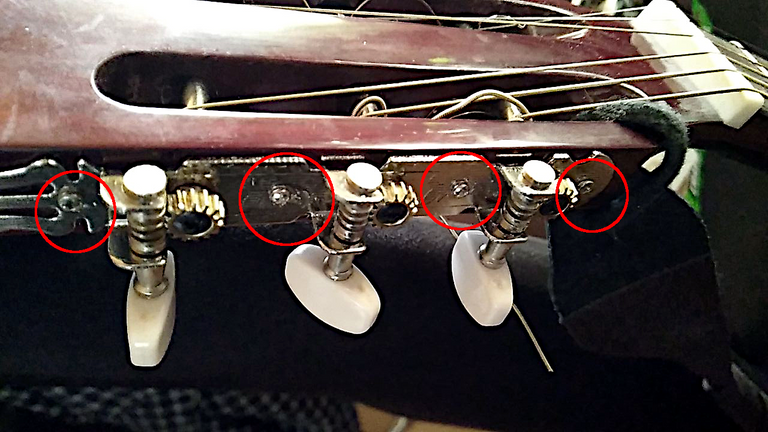
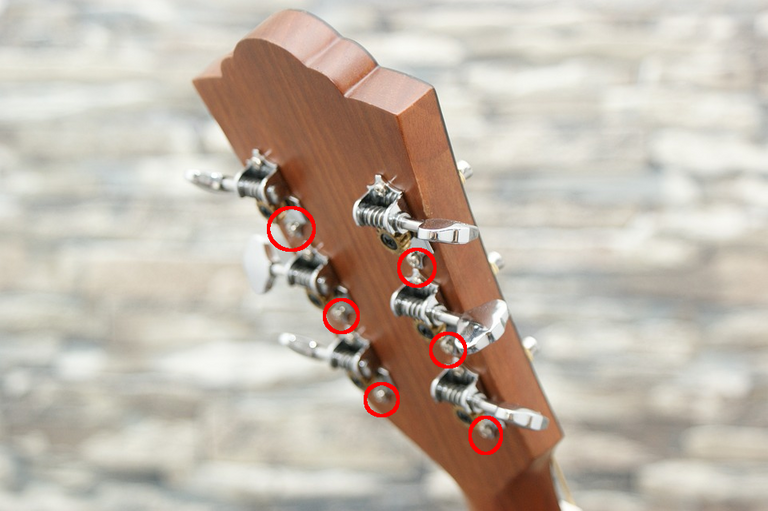

Demontage
Um die alten Mechaniken ausbauen zu können, müssen zuerst die Saiten von den Stimmwirbeln herunter gewickelt werden.
Wenn du dir nicht sicher bist, in welche Richtung du drehen sollst, dreh ein wenig in eine Zufällige Richtung - Wenn der Ton der Saite beim Zupfen tiefer wird, hast du in die richtige Richtung gedreht.
Tipp: Nachdem du die Saiten abgewickelt hast, rolle sie bis zum Steg zu kleinen Bündeln zusammen, damit sie dir bei den weiteren Arbeiten nicht im Weg herumhängen.

Anschließend kannst du die Montageplatten lösen. Entferne dazu die Schrauben, die direkt auf dem Blech aufliegen (siehe Foto unten).
Sollte deine Gitarre mit einzelnen Stimmwirbeln versehen sein, die nicht in einen Montagesatz zusammengefasst sind, löse deren Schrauben, die im Kopf befestigt sind. Sie befinden sich in der Regel auf der Rückseite des Gitarrenkopfes.
Nachdem die Schrauben entfernt wurden, kannst du die Wirbel aus den Fräsungen herausziehen.


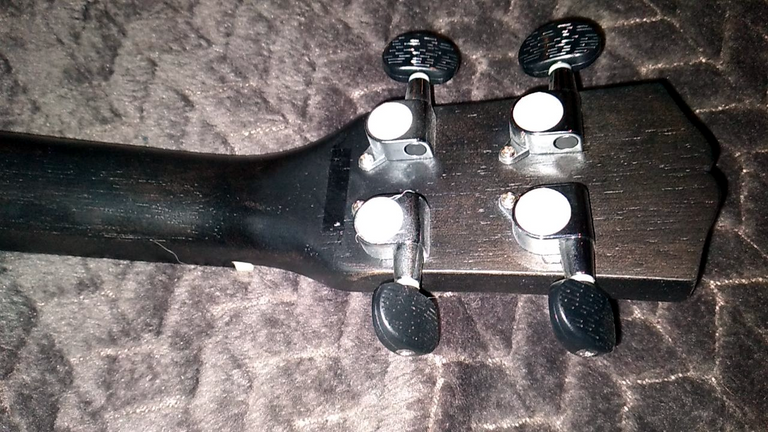
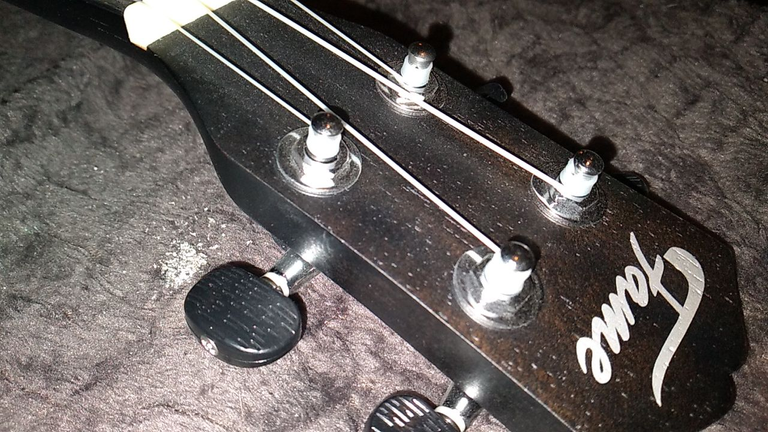
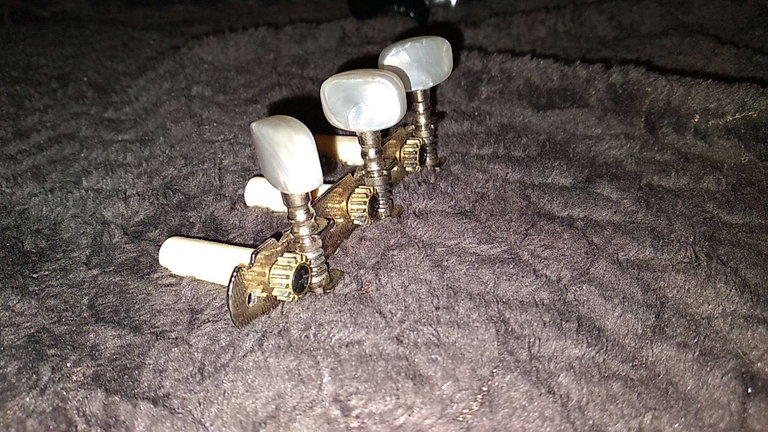
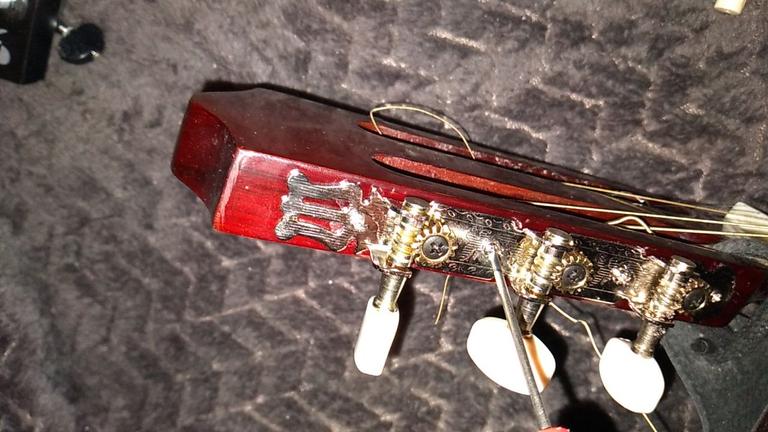
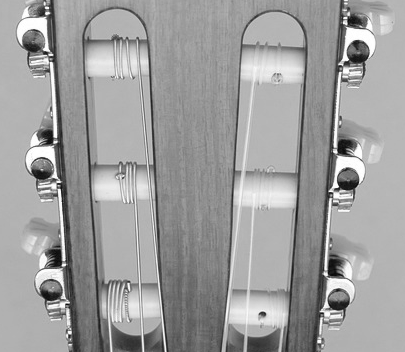

Assembling
Good news is, the process of assembling and disassembling is almost exactly the same. Just the other way around. :-)
If your tuning pegs are combined in assembly sets (side mounting), it is advisable not to tighten the screws too much yet. Now tighten them starting from the middle screws and working towards the outer screws so that the mounting plate does not warp in the middle.
Now the strings can be fixed.
For side-mounted tuning pegs, first turn the threading holes in the shafts towards the front side.
Then pull the strings directly through the holes. Then bring the strings back to the front, pass them under the string and put them back over the shaft to the back. Now tighten the loop that has been created. When tightening, make sure that the strings are in their correct nut notches.
If your tuning pegs are attached behind the head, turn the threading holes of the tuning pegs so that they face left and right. Then put the strings into the hole on the inside and thread it outwards away from the guitar head. The strings should be loosely tensioned by hand.
Now make a loop by pulling the end of each string through itself. If you have done this correctly, the end of each string will be pointing towards the neck of the guitar.
You can now put tension on the strings.
Now the guitar just needs to be tuned.
I myself like to do this with the help of the Android smartphone app Tunerly.

Montage
Die gute Nachricht ist, Montage und Demontage gehen fast genau gleich von statten. Nur Umgekehrt. :-)
Sollten deine Stimmwirbel in Montagesätzen (seitliche Montage) zusammengefasst sein, ist es ratsam, die Schrauben noch nicht gleich fest anzuziehen. Drehe sie erst anschließend von den mittigen Schrauben aus, hin zu den äußeren Schrauben fest zu, damit sich das Montageblech nicht verzieht.
Nun können die Saiten eingespannt werden.
Bei seitlich montierten Stimmwirbeln, dreh zuerst die Einfädel-Löcher in den Wellen nach vorne.
Ziehe dann die Saiten direkt durch die Löcher. Hole die Saiten dann wieder nach vorne, führe sie unter der Saite durch und lege sie wieder über die Welle nach hinten. Nun ziehe die, dabei entstandene Schlaufe fest. Achte beim Anziehen, dass die Saiten jeweils in ihren Sattelkerben liegen.
Bei hinter dem Kopf befestigten Stimmwirbeln, drehe die Einfädel-Löcher der Stimmwirbel so, dass sie links und rechts schauen. Stecke dann die Saiten in das innen liegende Loch und fädel es nach außen vom Gitarrenkopf weg. Die Saiten sollten dabei locker durch Handzug gespannt sein.
Nun mache eine Schlaufe, indem du das Saitenende durch sich selbst durchziehst. Wenn du dabei alles richtig gemacht hast, zeigt das Saitenende Richtung Gitarrenhals.
Du kannst die jeweilige Saite nun Spannen.
Nun muss die Gitarre nur noch gestimmt werden.
Ich mache das selbst gerne mithilfe der Android Händi-App Tunerly.
Best regards | Viele Grüße
QuantumG
https://pixabay.com/de/photos/gitarrenkopf-gitarre-gitarrensaiten-2809612/
Image sources | Bildquellen
https://pixabay.com/de/photos/gitarre-gitarrenhals-musikinstrument-1585656/
https://pixabay.com/de/photos/gitarre-musikinstrument-instrument-1546755/
https://pixabay.com/de/photos/gitarre-gitarrenkopf-musikinstrument-1396785/
https://pixabay.com/de/photos/gitarre-gitarren-stimmung-musik-2301724/
https://pixabay.com/de/photos/instrument-gitarre-akustisch-musik-6874022/
https://pixabay.com/de/photos/feuer-flammen-rot-hei%c3%9f-brennen-2821775/
https://pixabay.com/de/photos/schraubenzieher-werkzeug-handwerk-2038885/
╭━━⋞ ☙ My NFT artworks ≻≺ ♖ My dCity ⋟━━╮
╰━━━━⋞ ♫ My Rising Star(s) ⋟━━━━╯
Ui, das ist was für @richie8012 und @music-nature
unseren Gitarren Profis...
lg !PGM , !LOL mit etwas !hiqvote 🤠
BUY AND STAKE THE PGM TO SEND A LOT OF TOKENS!
The tokens that the command sends are: 0.1 PGM-0.1 LVL-0.1 THGAMING-0.05 DEC-15 SBT-1 STARBITS-[0.00000001 BTC (SWAP.BTC) only if you have 2500 PGM in stake or more ]
5000 PGM IN STAKE = 2x rewards!
Discord
Support the curation account @ pgm-curator with a delegation 10 HP - 50 HP - 100 HP - 500 HP - 1000 HP
Get potential votes from @ pgm-curator by paying in PGM, here is a guide
I'm a bot, if you want a hand ask @ zottone444
lolztoken.com
In a Thai con-do.
Credit: reddit
@quantumg, I sent you an $LOLZ on behalf of @reiseamateur
Use the !LOL or !LOLZ command to share a joke and an $LOLZ
(2/6)
Danke! Das sind wirklich gute Tipps!
!LUV
@reiseamateur, @richie8012(1/1) sent you LUV. | tools | discord | community | HiveWiki | NFT | <>< daily
NFT | <>< daily
Vielen Dank! :-)
!BEER
View or trade
BEER.Hey @richie8012, here is a little bit of
BEERfrom @quantumg for you. Enjoy it!Did you know that <a href='https://dcity.io/cityyou can use BEER at dCity game to buy cards to rule the world.
!BEER
Vielen Dank, auch fürs Weitersagen. :-)
!BEER
View or trade
BEER.Hey @reiseamateur, here is a little bit of
BEERfrom @quantumg for you. Enjoy it!Learn how to earn FREE BEER each day by staking your
BEER.Ohja, das stimmt! 👍😊👍
@reiseamateur, the HiQ Smart Bot has recognized your request (2/5) and will start the voting trail.
In addition, @quantumg gets !PIZZA from @hiq.redaktion.
For further questions, check out https://hiq-hive.com or join our Discord. And don't forget to vote HiQs fucking Witness! 😻
Super Blog! 👍